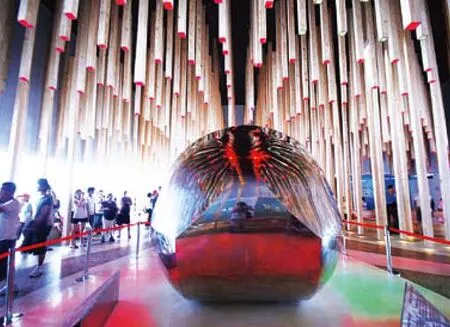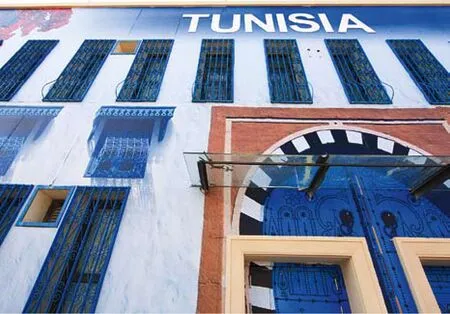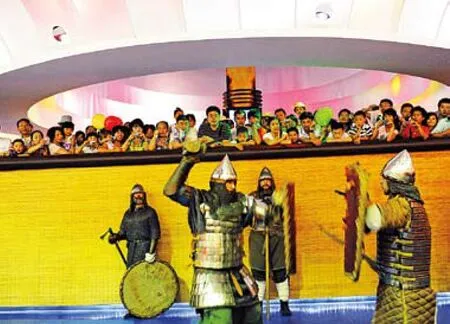Making an Impact
By WANG HAIRONG
Making an Impact
By WANG HAIRONG
Many tiny Expo pavilions offer a refreshing experience
It is quite a physical challenge to tour all the exhibits of the more than 200 participant countries, regions, international organizations and businesses at the ongoing World Expo in Shanghai. So, many visitors choose to see the bigger and famous pavilions first. But while larger pavilions feature more science and technology, smaller pavilions are the places to see pristine scenery, unique housing, exotic customs and fun activities.
Into Africa
Because of its distance to China and its diversified and unique cultures, Africa is a mysterious land for many Chinese. The Africa Joint Pavilion houses exhibits from more than 40 African countries and offers a rare opportunity for visitors to catch a glimpse of the continent.
The exterior wall of the Africa Joint Pavilion depicts a typical sunset on the African prairie. Silhouetted against the colorful clouds are a tree with a huge canopy,elephants, giraffes, zebras and other animals.
A wall of 29 faces, including that of Lucy, a female hominid—the ancestor of modern human beings, greets visitors at the entrance to the pavilion. Africa is thought to be the birthplace of mankind. Lucy’s remains were discovered in Ethiopia in 1974.She is estimated to have lived there 3.2 million years ago.
Many pavilions take unique shapes that re fl ect their natural environment and culture.The Benin Pavilion looks like a chateau,with creamy coffee-colored walls and light gray cone-shaped roofs. The pavilion draws inspiration from a royal palace and traditional residential buildings in the country. Inside the pavilion are exhibitions on urban and rural life in the country, its traditional culture and valuable handicrafts such as bronze work,woodcarvings, copper sculptures and ivory carvings.
A Yardang landform is featured at the entrance of Chad Pavilion. Yardang is a rock ridge formed by persisting wind and water erosion and often looks bizarre and spectacular. In the Sahara Desert in northeast Chad, there are many natural arches typical of Yardang landforms. On the pavilion’s walls,films show the country’s fascinating landscapes and folk culture.
The elegant mushroom-shaped house of the Cote d’lvoire Pavilion looks like a scene from wonderland. Adopting the three colors of the country’s national fl ag—orange,white and green, the house looks pleasant and stylish.
An imposing elephant-shaped rock welcomes visitors to the Namibia Pavilion.Beside the rock is a tall baobab tree. In the pavilion, by following signposts of distinct traditional styles, visitors can travel through the beautiful Fish River Canyon and 11 key cities and regions of Namibia. The pavilion has provided visitors with a small Namibian shed, where they can take a rest and enjoy delicious local cuisine. In order to create a genuine Namibia atmosphere, the pavilion’s staff members are all Namibians.
At the Seychelles Pavilion visitors are greeted by the beautiful Coco de Mer palm forest, shimmering blue waves of the sea and the grotesque-shaped stones. The pavilion seeks to give visitors a view of Seychelles’s natural scenery.
In the Comoros Pavilion, visitors can see a specimen of coelacanth, the oldest breed of fi sh in the world. Coelacanth was thought to have been extinct 80 million years ago until a living one was discovered in Comoros in 1938. The fish is now one of the country’s national treasures.
Idi Nadhoim, the country’s Vice President, told Chinese media in July that“in Comoros, the coelacanth is a symbol of longevity, while we know in China fi sh are regarded as auspicious creatures, thus we display the fi sh here to express our best wishes to Chinese people.”
Comoros gave the specimen to China in 1997. It was on show at the Beijing Museum of Natural History before it was displayed at the World Expo in Shanghai.
Singing and dancing is part of life in the Africa Joint Pavilion. Mali’s band,Uganda royal dance, Kenya’s village shows,Djibouti’s dagger dance, Togo’s mask dance,Burundi’s drum music, Cameroon’s music and dance, and Niger’s fashion show are performed on a daily basis on the joint pavilion’s central stage.
On to the islands
Small island states are housed in the Pacific Pavilion and the Caribbean Community Joint Pavilion at the World Expo site.
The Paci fi c Pavilion is a blue rectangular building painted with sketches of marine creatures. The pavilion hosts exhibitions by Vanuatu, Papua New Guinea, Palau, Tonga,Micronesia, Samoa, Fiji, Cook Islands,Kiribati, Solomon Islands, Tuvalu, Marshall Islands, Nauru and Niue as well as the South Paci fi c Tourism Organization and the Paci fi c Islands Forum. It showcases the beauty of the Paci fi c countries, their unique culture and a sustainable lifestyle.
Inside the unassuming structure, there are surprises and festivities. Chen Haiyun, a university student from Guangdong Province,won free round-trip tickets to Fiji, reported the World Expo’s official website. Chen visited the Paci fi c Pavilion on July 16, and he won the award because he was the 3 millionth visitor to the pavilion. Against the backdrop of rhythmic aboriginal percussion music, a South Pacific Tourism Organization officer presented the gift to Chen, and promised that the organization would pay for all of Chen’s accommodation in Fiji.

BALANCED:A huge stainless-steel Gomboc on display at the Hungary Pavilion on July 22

TUNISIA AT EXPO: The facade of the Tunisia Pavilion takes on the blue color of the Mediterranean Sea
Kiribati celebrated its National Pavilion Day on July 13. Artists from Kiribati performed traditional dances characterized by outstretched arms and birdlike movements.Kiribati is composed of 32 atolls and one island, straddling the equator and bordering the International Date Line to the east.
On July 17, the Caribbean Community also celebrated its Pavilion Day. Artists from Caribbean countries performed local dances and songs. Through exhibits and multimedia presentations, the Caribbean Community showcased its cultural heritage, natural landscape and resources, clean energy development and other highlights.
Other discoveries
There are other smaller pavilions scattered around the Expo site, waiting to be discovered.
The Israel Pavilion has an elegant and novel shape. Part of the pavilion is glass and steel,and part is of brick and mortar. It looks like a glass water jar leaning against a sand dune.

HISTORICAL EXPERIENCE:Visitors to the Lithuania Pavilion watch a replica fight of 15th-century medieval knights on July 18
The pavilion consists of three areas—the Whispering Garden, Hall of Light and Hall of Innovations. Trees in the Whispering Garden,a green orchard at the entrance, whisper in both English and Chinese when visitors walk close to them. A 15-meter-high screen in the Hall of Light shows films highlighting the country’s innovations and technological achievements. A special audio-visual presentation in the Hall of Innovations allows visitors to talk with Israeli children, scientists, doctors and inventors via hundreds of screens.
Readers would fi nd the Slovenia Pavilion the right place to go. The pavilion’s exterior resembles a stack of books on shelves. At the entrance, visitors can pick up a copy of an essay entitledThe Time of the End of Timeby Slovenian philosopher Slavoj Zizek. Seven huge “opened books” are standing on the fl oor. All the gigantic books display images of the Slovenian countryside, brief text descriptions and a video presentation. The fi rst book printed in Slovenian is exhibited.
The Hungary Pavilion is decorated with more than 800 wooden rods. These wooden rods not only re fl ect light, but will also rise and fall with changing music rhythms.
Under the suspending rods sticking from the ceiling is a huge stainless-steel ball called Gomboc. It was invented by two Hungarian engineers, Gabor Domokos and Peter Varkonyi. The Gomboc is the world’s fi rst self-righting object. It is a convex threedimensional homogeneous body that has just one stable and one unstable point of equilibrium when put on a fl at surface. It returns to one equilibrium position no matter how it is pushed or turned around. It behaves like a roly-poly toy, but the difference is that the density of a roly-poly toy varies across its body, but that of a Gomboc does not. In the Hungary Pavilion, visitors can also play with smaller Gomboc pieces made from aluminum, copper, brass and plexiglass.
In the Bangladesh Pavilion, a vigorous campaign was launched on July 19 to promote the Sundarbans Forest, its UNESCO world heritage and a candidate for the new Seven Natural Wonders of the World. The Sundarbans Forest is densely covered by mangrove forests, and is one of the largest reserves for the Bengal tiger. It is also home to more than 260 kinds of birds, reptiles and invertebrate species, including the saltwater crocodile. The new seven natural wonders will be announced on November 11, 2011 among all 28 candidates from six continents.
Visitors to the Lithuania Pavilion during July 13 to 20 were able to watch a replica fight of 15th-century medieval knights.Knights armed with swords, spears and shields show battle tactics used in those days.
The design of the Lithuania Pavilion came from flowers in bud, symbolizing a vigorous, prosperous and booming country and its cities. The exhibition centers on the success stories of urban development, architectural and cultural heritage, sports and scienti fi c development, among others.

